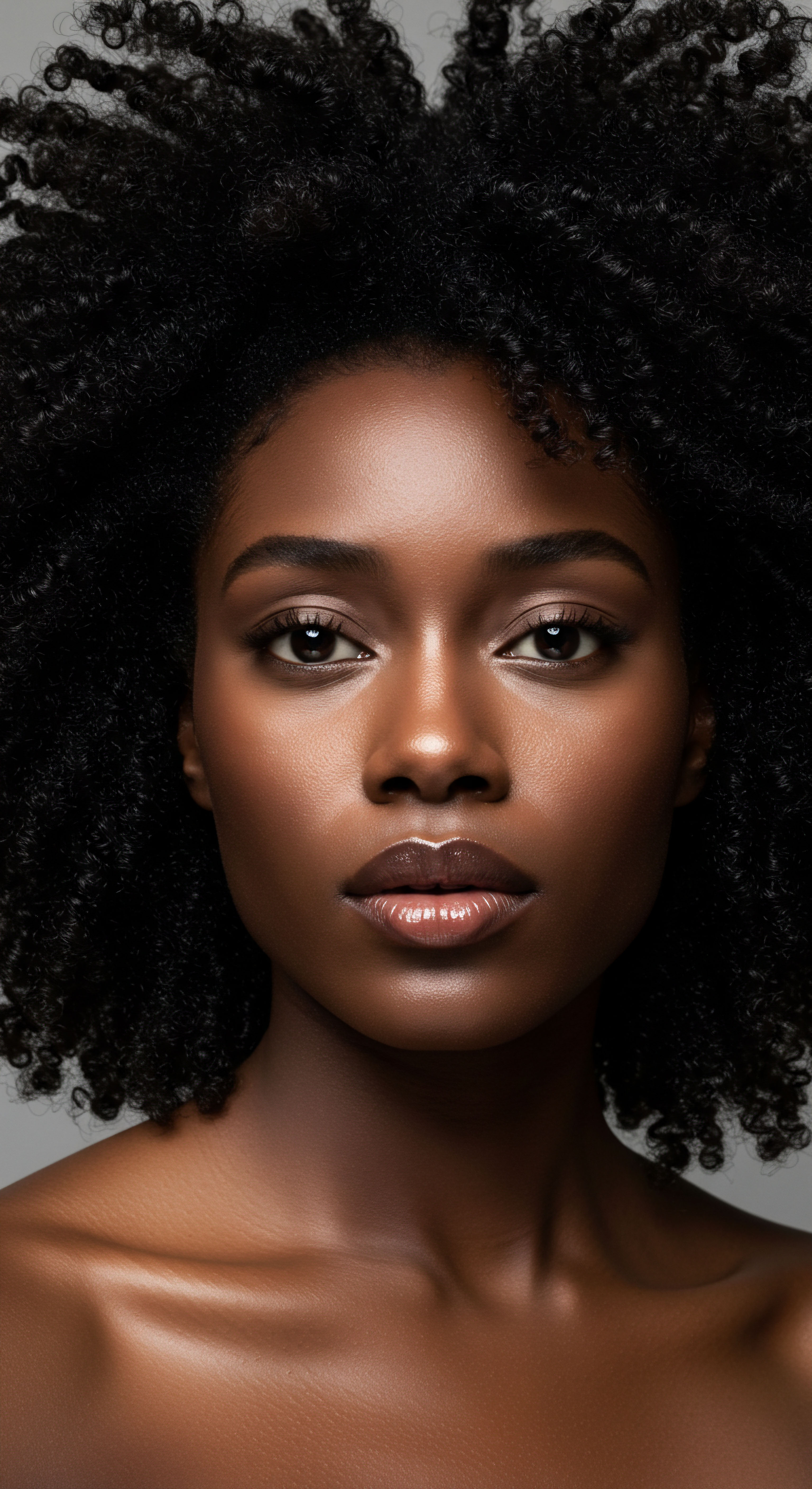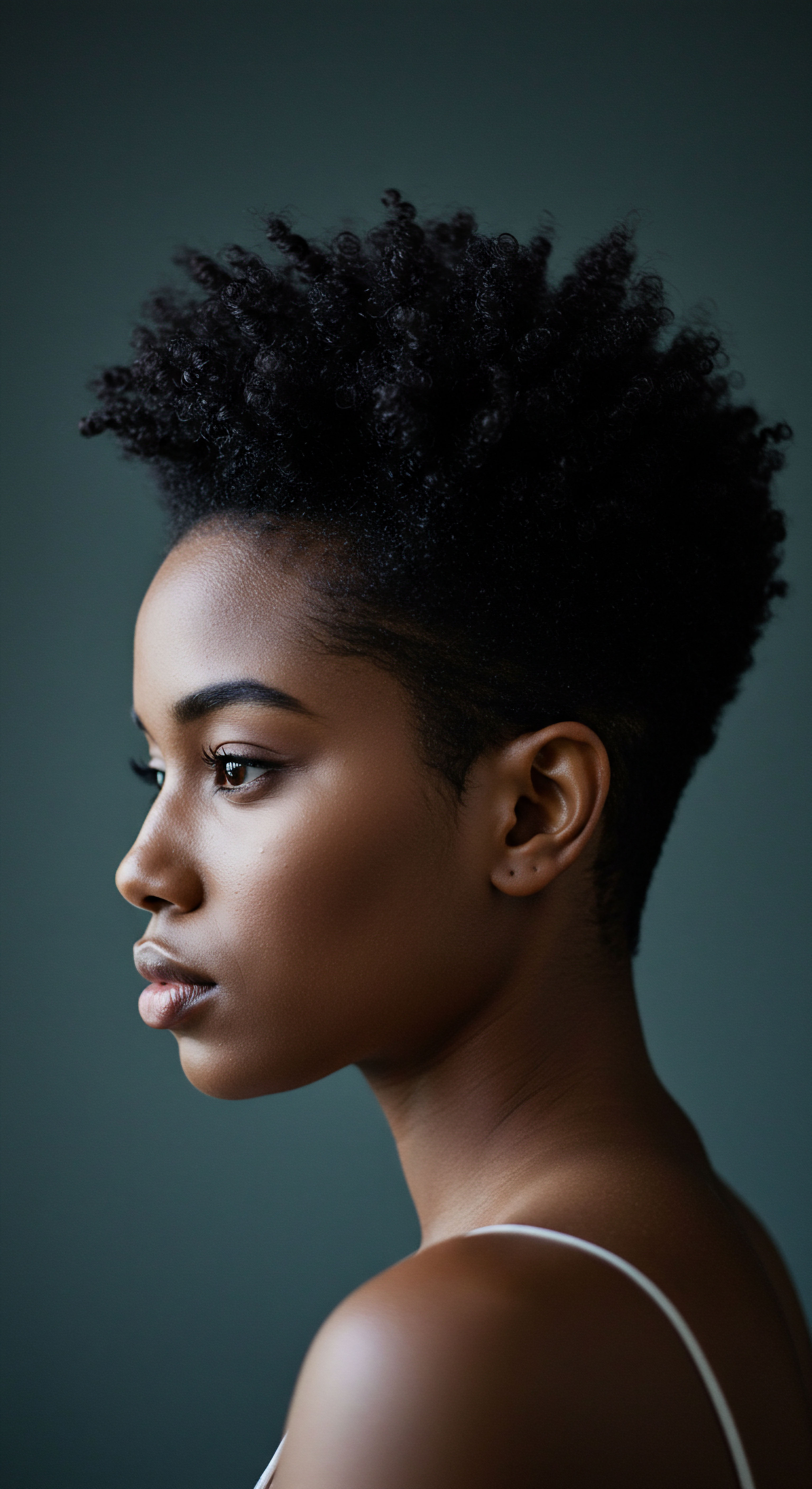
Roots
Consider for a moment the quietude of nightfall, a time when the world softens its edges, and our bodies seek repose. Even in this stillness, for many, the care of our hair persists, a gentle echo of daily rituals. This enduring practice, the thoughtful preparation of our strands for sleep, stretches back through the long corridors of human history, a silent testament to hair’s profound role in our lives.
Across civilizations long past, the fibers that crown our heads held more than mere aesthetic value; they were symbols, conduits, and often, delicate barometers of health and status. Understanding the ways ancient peoples tended to their hair as dusk descended reveals a fascinating interplay of cultural belief, available resources, and practical wisdom.

Hair’s Elemental Nature
At its very core, hair is a marvel of biological design. Each strand, though seemingly simple, comprises complex protein structures that determine its texture, strength, and resilience. This inherent composition meant that, regardless of era or geography, certain universal truths applied to its preservation.
Protection from tangling, prevention of breakage, and maintenance of moisture were always concerns, even if the methods varied dramatically. The sheer diversity of human hair, from tightly coiled springs to straight, flowing cascades, naturally led to distinct approaches to its care, particularly when preparing for the vulnerable hours of sleep.
The preparation of hair for nighttime repose reflects a timeless human endeavor to protect and honor one’s crowning glory.

Ancient Perceptions of Hair’s Qualities
Early societies often imbued hair with significance far beyond its physical attributes. For some, it held spiritual power, a connection to the divine or ancestral realms. For others, it served as a clear indicator of social standing, marital status, or tribal affiliation. This deep regard meant that hair was not simply an accessory to be neglected once the sun set.
Rather, its nighttime treatment became an extension of its daytime prominence, a private ritual safeguarding its health and symbolic meaning. The materials available, whether indigenous plant oils or finely spun fabrics, dictated the specific techniques, yet the underlying intention to preserve and respect remained constant.
- Cultural Reverence Hair often symbolized spiritual power or social standing.
- Practical Preservation Protection from tangling and breakage was a universal concern.
- Material Influence Local resources shaped specific care techniques and tools.

Ritual
As the day’s light softened and the evening chill settled, a different kind of care often began for hair. This was not the public display of intricate styles, but a more intimate, protective series of actions, designed to shield strands from the rigors of sleep and prepare them for the coming day. For those with textured hair, the need for such vigilance was particularly pronounced, as delicate curls and coils are prone to friction and moisture loss against rough surfaces. This segment explores the shared practices and materials that offered a nocturnal sanctuary for hair, even as their specific forms adapted to regional climates and available resources.

Nightly Preparations for Hair Protection
Across many ancient regions, a common thread in nighttime hair care involved some form of covering or wrapping. This served multiple purposes ❉ to prevent tangling, to maintain elaborate daytime styles, to protect against environmental elements, and to keep hair clean. In warmer climates, light linen or finely woven nets might have sufficed, allowing for air circulation while keeping hair contained.
In colder regions, thicker fabrics or even animal skins could have offered warmth and protection. The ingenuity of these early solutions speaks to a universal understanding of hair’s vulnerability during sleep.

What Common Materials Offered Nightly Hair Sanctuary?
The choice of materials for nighttime hair protection was intrinsically linked to the environment and local agriculture. In ancient Egypt, for example, finely spun linen was abundant and served as a versatile material for clothing, wraps, and even hair coverings. Roman women might have utilized wool or more luxurious silk for their hair nets, depending on their social standing. In parts of ancient China, the cultivation of silk worms led to the widespread use of silk fabrics, prized for their smooth texture and ability to reduce friction.
Similarly, in various African communities, natural fibers like cotton or even specially prepared leaves and barks could have been fashioned into protective coverings. The ingenuity extended to the use of oils and balms, applied before wrapping, to condition and moisturize the hair overnight.
| Region Ancient Egypt |
| Common Materials Linen cloths, hair nets |
| Primary Purpose Preservation of wigs, protection from dust |
| Region Ancient Rome |
| Common Materials Wool, silk nets (reticula) |
| Primary Purpose Maintaining elaborate styles, modesty |
| Region Ancient China |
| Common Materials Silk wraps, wooden pins |
| Primary Purpose Reducing friction, preserving length |
| Region Sub-Saharan Africa |
| Common Materials Cotton wraps, plant fibers |
| Primary Purpose Protection from tangling, moisture retention |
| Region Diverse materials served the universal need for nocturnal hair care. |
Nighttime hair care practices, though varied in form, shared a common aim of safeguarding hair from friction and environmental exposure.

Tools and Techniques for Nocturnal Care
Beyond coverings, specific tools and techniques also played a part in preparing hair for sleep. Combs, often crafted from wood, bone, or ivory, were essential for detangling and smoothing strands before they were wrapped or braided. In some cultures, a nightly combing ritual was not only practical but also meditative, a moment of quiet reflection. Oils, derived from local plants such as olive, almond, or castor, were applied to lubricate and condition, offering a barrier against dryness.
These emollients would often be left on overnight, allowing their properties to penetrate the hair shaft, preparing it for the next day’s styling or simply maintaining its vitality. The practice of braiding or twisting hair before sleep was also widespread, particularly for those with longer or more textured strands, to prevent matting and tangles.

Relay
Moving beyond the universal principles of hair protection, we step into a more nuanced exploration of how nocturnal hair care truly diversified across the ancient world. The inquiry into whether these practices varied by ancient region reveals a fascinating interplay of climate, social hierarchy, spiritual conviction, and technological advancement. It becomes clear that a single, monolithic approach to nighttime hair care never existed; instead, a rich mosaic of customs emerged, each distinctly shaped by its unique cultural landscape. This deeper consideration requires us to look beyond simple methods and appreciate the intricate reasons behind their adoption.

Ancient Egypt’s Elaborate Nocturnal Regimens
In ancient Egypt, hair care, including nighttime routines, was inextricably linked to hygiene, social standing, and religious belief. Both natural hair and the elaborate wigs favored by the elite received meticulous attention. For those who wore wigs, which were often heavy and complex, nightly removal and careful storage were essential. These wigs, crafted from human hair, plant fibers, or even wool, would be placed on stands or in special boxes to maintain their shape and prevent damage.
Natural hair, when not covered by a wig, was often braided or twisted before sleep. Archaeological findings and textual evidence point to the widespread use of rich oils and animal fats, like castor oil, moringa oil, and even beef fat, which were massaged into the scalp and strands. These applications served as deep conditioners, emollients, and even treatments for common scalp conditions.

How Did Geography Influence the Nocturnal Adornment of Hair?
The arid climate of Egypt, for instance, necessitated intensive moisturizing. The dry air could quickly dehydrate hair, making the application of fatty oils before sleep a practical necessity for maintaining suppleness and preventing breakage. The widespread practice of shaving heads among priests and certain classes also played a role; for those who did not shave, the focus was on protection and conditioning. Furthermore, the Egyptian belief in cleanliness as a path to spiritual purity extended to hair, meaning even during sleep, hair was kept tidy and often covered to ward off dust and insects.
A study published in the Journal of Archaeological Science analyzing hair samples from ancient Egyptian mummies, including those from the New Kingdom, revealed the presence of a fatty substance consistent with a mixture of plant oils and animal fats. This composition, found consistently across various samples, suggests a pervasive and deliberate application of conditioning agents, likely for both daytime styling and overnight restorative purposes. This provides concrete evidence of a widespread, consistent approach to hair conditioning, likely including nocturnal applications, aimed at preserving hair health in a challenging environment.
- Egyptian Wigs Carefully stored on stands or in boxes to retain form.
- Oils and Fats Castor, moringa, and animal fats applied for conditioning.
- Climate Adaptation Dry air necessitated rich emollients to prevent dehydration.

Roman and Greek Hair Practices at Night
In contrast to the Egyptians, ancient Romans and Greeks, particularly the upper classes, focused heavily on elaborate daytime coiffures that required significant preparation. For Roman women, whose hairstyles could involve complex braids, curls, and pins, preserving these styles overnight was paramount. They often wore hair nets, known as reticula, made from fine gold, silver, or silk threads, to hold their intricate arrangements in place.
Before donning these nets, hair might be oiled with olive oil or other aromatic balms to add shine and suppleness. The purpose was less about deep treatment and more about maintaining the sculpted look for the next day, reducing the arduous process of re-styling.
Similarly, in ancient Greece, women used head coverings and ribbons to protect their often long and flowing hair. While less is documented about specific nightly treatments compared to Egypt, the use of fragrant oils and simple wraps was common. The focus was on maintaining cleanliness and preventing tangles, ensuring the hair remained presentable for the next day’s simple yet elegant styles. The cultural emphasis on natural beauty meant less intervention was needed overnight compared to the more artificial Roman trends.

East Asian Traditions and Silk’s Influence
Across ancient East Asia, particularly in China and Japan, long, straight, and often dark hair was highly prized. Nighttime care here frequently involved meticulous combing rituals and the use of silk. Women would often comb their hair 100 times before bed, a practice believed to stimulate circulation and distribute natural oils. Hair was then typically braided or wrapped in silk cloths.
Silk, with its smooth surface, minimizes friction, preventing tangles and breakage, and helping to retain the hair’s natural luster. Camellia oil was a popular choice for conditioning, applied to the hair and scalp before wrapping, known for its nourishing properties. This practice was not just about physical care but also held a meditative quality, a moment of self-care and quiet preparation for the day ahead.

African Regions and Protective Styles
The diverse cultures across ancient African regions developed a rich array of nighttime hair care practices, deeply rooted in protective styling and the use of indigenous plant-based ingredients. For many, braiding, twisting, or cornrowing hair before sleep was a common practice. These styles not only protected the hair from tangling and breakage but also served to retain moisture, which was particularly important in varied climates. Natural butters and oils, such as shea butter, palm oil, and various plant extracts, were generously applied to nourish the scalp and hair.
These practices were often communal, passed down through generations, and carried significant cultural and social meaning, often extending beyond mere aesthetics to include spiritual protection. The very act of preparing hair for sleep became a continuation of the day’s cultural expression and care.
| Region Ancient Egypt |
| Key Nighttime Practice Wig storage, oiling natural hair |
| Primary Material Linen, castor oil, animal fats |
| Underlying Cultural/Environmental Factor Arid climate, wig culture, spiritual purity |
| Region Ancient Rome |
| Key Nighttime Practice Hair net use (reticula) |
| Primary Material Silk, wool, olive oil |
| Underlying Cultural/Environmental Factor Elaborate daytime styles, social status |
| Region Ancient China |
| Key Nighttime Practice Silk wrapping, ritualistic combing |
| Primary Material Silk, camellia oil |
| Underlying Cultural/Environmental Factor Value of long hair, meditative practices |
| Region Ancient Africa |
| Key Nighttime Practice Protective braiding, oil application |
| Primary Material Shea butter, plant extracts, cotton wraps |
| Underlying Cultural/Environmental Factor Diverse climates, communal traditions, moisture retention |
| Region Nocturnal hair care practices were highly individualized by regional needs and beliefs. |
The nocturnal hair care rituals of antiquity paint a vibrant picture of regional diversity, shaped by environmental necessity and deeply held cultural convictions.

Reflection
As we journey through the quiet hours of ancient nights, observing the varied ways our ancestors cared for their hair, a profound understanding begins to surface. The practices were not uniform, nor could they have been, given the vast differences in climate, resources, social structures, and spiritual convictions that defined each civilization. From the meticulously preserved wigs of Egyptian nobility to the silk-wrapped tresses of Chinese scholars, and the richly oiled braids of African communities, each approach speaks volumes about a people’s relationship with their own being and the world around them.
These historical insights remind us that hair care, then as now, extends beyond mere vanity. It is a dialogue between self and environment, a testament to ingenuity, and often, a quiet act of reverence for the very fibers that connect us to our heritage. The echoes of these ancient nocturnal rituals continue to resonate, inviting us to consider the enduring significance of our own nightly routines, and perhaps, to find a deeper sense of connection to the long, beautiful story of human hair.

References
- Lucas, A. (1962). Ancient Egyptian Materials and Industries. Edward Arnold Publishers.
- Stewart, H. (2007). Cosmetics and Perfumes in the Ancient World. The British Museum Press.
- Bard, K. A. (2007). An Introduction to the Archaeology of Ancient Egypt. Blackwell Publishing.
- Lersch, P. (1862). Geschichte der Haartracht (History of Hairdressing). J. H. Schmalz.
- Robins, G. (1994). Proportion and Style in Ancient Egyptian Art. University of Texas Press.
- Olson, K. (2008). Dress and the Roman Woman ❉ Self-Presentation and Society. Johns Hopkins University Press.
- Sherrow, V. (2006). Encyclopedia of Hair ❉ A Cultural History. Greenwood Press.
- Fletcher, J. (2015). Hair ❉ A Cultural History of Hair from Ancient Egypt to the Present Day. Thames & Hudson.
- Rühli, F. J. et al. (2010). Chemical analysis of hair from ancient Egyptian mummies ❉ A multidisciplinary approach to hair care practices. Journal of Archaeological Science, 37(1), 159-165.